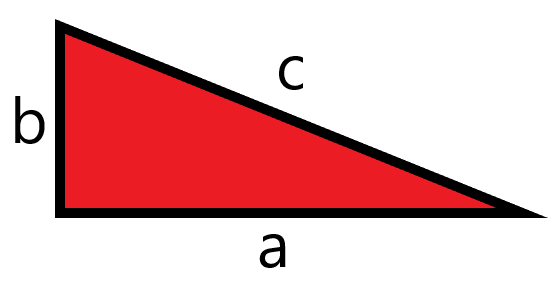Overview
Students can connect algebra to geometry by expressing geometric inequalities in compound inequality form. Since the sum of the lengths of any two sides of a triangle is greater than the length of the third side, there are three inequality statements. All three inequality statements must be true for three line segments to form a triangle.
The Triangle Inequality
The perimeter of any polygon is the sum of the measurements of its sides. Therefore, the perimeter of a triangle is the sum of the measurements of its three sides. Suppose a triangle has 3 sides with measurements a, b, and c. In Euclidean geometry, there are 3 basic inequality statements for any triangle: a +b > c; b +c > a; a +c > b.
Right Triangles
In order for a triangle to be a right triangle, one angle must be a 90 degree angle. The sides of the triangle are in special relationship with one another, expressed by the Pythagorean Theorem, such that a2+ b2 = c2. Right triangles are a special case of the Triangle Inequality, such that the measure of the hypotenuse c is greater than the measure of either leg a or leg b. However, the measure of c must also be less than the sum of both legs. Suppose an isosceles triangle ABC is constructed so that AB and BC are equal. By definition, the base angles B and C are also equal. If an altitude CD is constructed, it will divide ABC into two right triangles, ACD and CBD. Euclid showed that both AD and CD are shorter than the hypotenuse AC. According to the Triangle Inequality, the measure of AD + CD must be greater than AC.
Non-Triangles
A figure made up of three line segments is not a triangle if any of the inequalities are untrue. Therefore, all three conditions must be satisfied such that a + b >c; a + c >b, and b + c =a. If any of the elements are untrue, the entire statement is untrue. Students can use the Triangle Inequality as a test for geometric figures, if given the lengths of any three line segments.
Special Triangles and the Triangle Inequality
One of the most famous of the special triangles is the 3-4-5 triangle. It got its name because one side measures 3 units, one side measures 4 units, and one side measures 5 units. It is also a right triangle, and demonstrates the Pythagorean Theorem, because 32+ 42= 52. It also follows the Triangle Inequality because 3 +4 & gt;5, 3 + 5 >4, and 4 + 5 >3. The sides of the 3-4-5 triangle follow an arithmetic progression. In algebraic terms, sides follow a pattern of a, a + d, and a + 2d. Let a be 3, then 3 + 1 is 4, and 3 + (2·1) = 5. It can be shown that any triangle that follows an arithmetic progression, and fulfills all three inequalities of the Triangle Inequality is similar to the 3-4-5 triangle. Suppose that three line segments follow the arithmetic progression 6, 7, 8. They will form a triangle, because 6 + 7 >8; 7 + 8 >6; 6 + 8 >7. They are also similar to 3, 4, 5 because 6-3 is 3, 7-3 is 4 and 8-3 is 5.
Interested in algebra tutoring services? Learn more about how we are assisting thousands of students each academic year.
SchoolTutoring Academy is the premier educational services company for K-12 and college students. We offer tutoring programs for students in K-12, AP classes, and college. To learn more about how we help parents and students in Gladstone, OR: visit: Tutoring in Gladstone, OR





